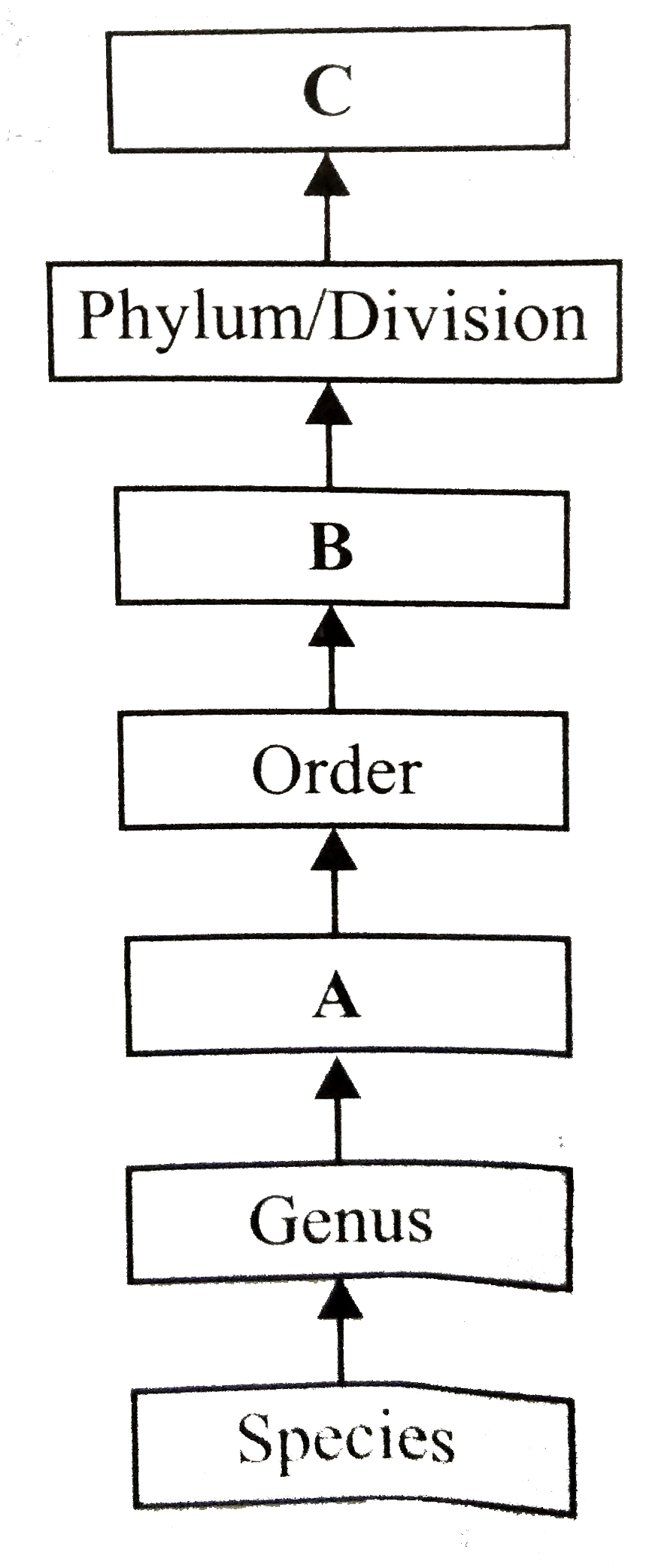As we go from species to kingdom in a taxonomic hierarchy, the number of common characteristics
will decrease
will increase
remain same
may increase or decrease
The correct Answer is:a
To solve the question, "As we go from species to kingdom in a taxonomic hierarchy, the number of common characteristics," we need to analyze the taxonomic hierarchy and the characteristics shared among organisms at different levels.
1. Understanding Taxonomic Hierarchy:
- The taxonomic hierarchy is a system used to classify living organisms. It includes several levels: species, genus, family, order, class, phylum, and kingdom.
- Each level groups organisms based on shared characteristics.
2. Characteristics at Different Levels:
- At the species level, organisms share a high number of specific characteristics. For example, all members of a species have similar reproductive, morphological, and genetic traits.
- As we move up the hierarchy from species to genus, family, order, class, phylum, and finally to kingdom, the organisms grouped together become more diverse.
3. Common Characteristics:
- In lower taxonomic categories (like species and genus), organisms share many specific traits.
- In higher taxonomic categories (like kingdom), organisms are grouped based on broader characteristics, which means they share fewer specific traits.
4. Conclusion:
- Therefore, as we move from species to kingdom, the number of common characteristics decreases. This is because the higher the taxonomic level, the more diverse the organisms become, leading to fewer shared characteristics.
5. Correct Answer:
- The correct option is A: The number of common characteristics will decrease.
- The taxonomic hierarchy is a system used to classify living organisms. It includes several levels: species, genus, family, order, class, phylum, and kingdom.
- Each level groups organisms based on shared characteristics.
- At the species level, organisms share a high number of specific characteristics. For example, all members of a species have similar reproductive, morphological, and genetic traits.
- As we move up the hierarchy from species to genus, family, order, class, phylum, and finally to kingdom, the organisms grouped together become more diverse.
- In lower taxonomic categories (like species and genus), organisms share many specific traits.
- In higher taxonomic categories (like kingdom), organisms are grouped based on broader characteristics, which means they share fewer specific traits.
- Therefore, as we move from species to kingdom, the number of common characteristics decreases. This is because the higher the taxonomic level, the more diverse the organisms become, leading to fewer shared characteristics.
- The correct option is A: The number of common characteristics will decrease.
Topper's Solved these Questions
- NCERT Exemplar Questions +1 (STRUCTURAL ORGANISATION IN ANIMALS )BOOK - TRUEMEN BIOLOGY ENGLISHCHAPTER - NCERT Exemplar Questions +1 (STRUCTURAL ORGANISATION IN ANIMALS )EXERCISE - MCQs
8 Videos
- NCERT Exemplar Questions +1 (TRANSPORT IN PLANTS) BOOK - TRUEMEN BIOLOGY ENGLISHCHAPTER - NCERT Exemplar Questions +1 (TRANSPORT IN PLANTS) EXERCISE - MCQs
12 Videos
Similar Questions
In a taxonomic hierarchy, the number of common characters will increase as we go from
View SolutionRead the following statements regarding living organisms . How many of the following statements are incorrect ?
(i) As we go higher from species to kingdom, the number of common characteristics goes on increasing .
(ii) Lower the taxa more are the characteristics that the members within the taxon share.
(iii) Lower the category , greater is the difficulty of determining the relationship to other taxa at the same level.
(iv) All organisms , including those in plants and animal kingdom , have sub - species as the lowest obligate category
View Solution
Knowledge Check
The given flow chart represents the hierarchy of various taxonomic categories.
Identify the missing categories (A, Ba nd C) and select the correct statements regarding these.
(i) A is the taxonomic category which contains a number of related genera.
(ii) Example of category B are Monocotyledonae, Dicotyledonae, Mammalia, etc.
(iii) C represents the basic unit of taxonomic hierarchy.
(iv) Examples of category C are Fungi, Monera, Protista, etc.
 A(i) and (ii)B(iii) and (iv)C(i), (ii) and (iv)D(i), (ii), (iii) and (iv)
A(i) and (ii)B(iii) and (iv)C(i), (ii) and (iv)D(i), (ii), (iii) and (iv)
How many are the incorrect statements from the followings:
a) Lower the taxa, more are the characteristics that the members within the taxon share
b) Higher the taxonomic category, greater is the difficulty of determing the relationships to other taxa at the same level.
c) In lower taxa as the problems of classification becomes more complex.
d) As we go higher from species to kingdom, the number of common characters increases.
View SolutionWhich one of the following obligate category in taxonomic hierachy will have maximum number of common characters?
View SolutionIn the hierarchy of classification, which grouping will have the smallest number of organisms with maximum common characteristics and which will have the largest number of organisms?
View SolutionChoose the correct answer from the options given below:
Which of the following is a common characteristic of a covalent compound?
View SolutionAssertion: Complexity of classification increases from kingdom to species
Reason. Common characters increase from kingdom to species
View SolutionSome of the taxonomic categories in the taxonomic hierarchy are given at random. Arrange them in correct ascending series : form, class, genus, order, species, family, variety.
View SolutionFind the correct statements from the followings
(A) Each rank or taxon, in fact represent a unit of classification
(B) Every step in taxonomic hierarchy represents a rank or category
(C) A taxonomic category is a part of overall taxonomic hierarchy
(D) Taxonomic categories are not distinct biological entities, they are only biological entities, they are only morphological aggregates
View Solution
